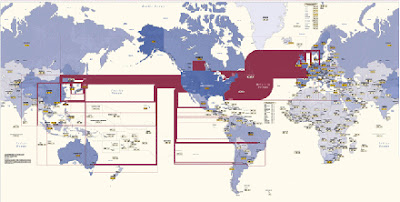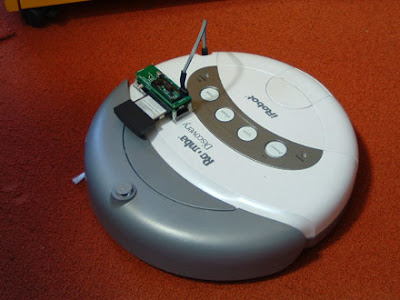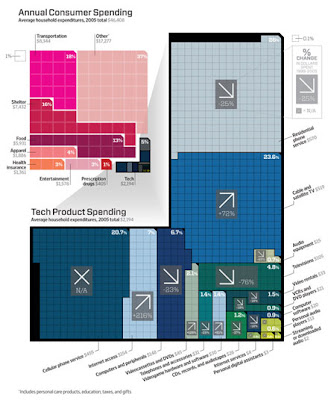Here's a Wiki-esque post that covers the full story on Black Google, I'm working on the Wikipedia entry but it's taking some time.
History
In January 2007, Mark Ontkush, the owner of the ecoIron blog, suggested that a large amount of energy could be saved if Google switched their home page from white to black. The initial savings was estimated to be 3000 Megawatt-hours a year; this was later rounded down to 750 Megawatt-hours, after an error in the calculations was found. At the time, ecoIron was receiving about 100 hits per day. The story was posted on Digg where it rapidly went to #1 on the main page, ultimately receiving over 4,000 Diggs. Tony Heap, the owner of HeapMedia, started the Blackle site shortly after these events.
Appearance and Functionality
The Blackle site uses the Google search engine and works in much the same way; users enter text into the box provided, and the query is sent to the Google search engine. The searches both use the same searching algorithm and are executed on the same hardware. However, it has been suggested that the result lists might differ. Blackle uses light grey text on a black background; this is in lieu of the customary Google layout of blue, black, and green text on a white background. Since it is not owned by Google Inc., the Blackle site lacks many of the features of conventional Google, including the 'Cached' and 'Similar Pages' options, and it does not have as many of the corresponding links that can be found on the Google homepage. These links include items such as preferences, advanced search, language tools, images, groups, news and scholar. None of the Blackle links have a visited option, where once a link is followed it turns a different color. The iGoogle feature is also lacking in Blackle.
Energy Savings
The principle is based on the the fact that different colors consume different amounts of energy on computer monitors. Depending on the manufacturing technology, and to a lesser degree the brand of the manufacturer, these colors and energy levels vary. An explanation is provided below.
Cathode Ray Tube (CRT) Monitors
A CRT monitor uses a cathode ray tube to display images. The back of the tube has a negatively charged cathode, and an electron gun shoots electrons down the tube and onto a charged screen. The screen is coated with a pattern of dots that glow when struck by the electron stream. Each cluster of three dots, one of each color, is one pixel. Certain colors, such as white, require all three dots to be charged, and are energy intensive to display. Other colors, such as black, requires no additional energy to produce and consume the least out of all the colors.
Therefore, power consumption for CRT monitors is primarily a function of the user's color settings and desktop graphics, and any given CRT monitor requires more power to display a light screen than a dark one. Other authors, such as Roberson et. al., have verified these results. The amount of energy saved from switching from white to black varies considerably on the size of the monitor. In a 2002 study, Roberson found that between 4 and 30W could be saved by switching from a white to a black screen. This translates into an 18 to 88% power savings per monitor. The US Department of Energy produced similar results, stating an average 15W savings per monitor. Several informal studies have also been done, with results ranging from a 7 to 23W reduction when using a black screen.
In the first quarter of 2006, Display Search, an industry reporting service, estimated that CRT monitors comprise 25.3% of all monitors in the world. There are substantial regional variations; for example, the report mentions that as of 2006, 45.3% of the monitors in China, and 62.8% in Latin America, were still CRTs.
Liquid Crystal Display (LCD) Monitors
A liquid crystal display (commonly abbreviated LCD) is a thin, flat display device. LCD monitor are suitable for many types of devices, including computer monitors and battery-powered electronic devices. Unlike CRT monitors, LCDs rely on a constant source of illumination, commonly known as a backlight. Backlights produce light in a manner similar to a CRT display, with the difference that the backlight is always on. Backlights can be any color; monochrome LCDs usually have yellow, green, blue or white backlights, while color displays use white backlights that cover most of the color spectrum.
A pixel in an LCD display typically consists of a layer of molecules aligned between two transparent electrodes. When a voltage is applied across the electrodes, a torque acts to align the liquid crystal molecules parallel to the electric field. This reduces the light shining through from the backlight, and the device appears gray. If the applied voltage is large enough, the liquid crystal molecules are completely untwisted; the results is that the backlight will then be completely blocked and the pixel will appear black. By controlling the voltage applied across the liquid crystal layer in each pixel, light can be allowed to pass through in varying amounts, correspondingly illuminating the pixel.
As such, LCD display technology is different from CRT technology, and the possibility exists that colors that are energy efficient to display on a CRT monitor (e.g. black) may not be as energy efficient to display on an LCD monitor. The Roberson study found that LCD monitors saved up to 3W by switching from a white to a black screen, and in no case did any of the LCD monitors use more energy displaying black than white. Recently, several informal studies have been done, with results ranging from a 2W reduction when displaying Blackle vs Google on an IBM Thinkvision LCD, to zero, up to a 1W increase.
Display Search estimated in Q12006 that LCD monitors have 74.7% penetration rate worldwide. Japan is the country with the highest rate; 99.3% of their monitors use LCD technology.
Plasma Displays
A plasma display panel (PDP) is a type of flat panel display commonly used for large TV displays, typically above 37" (940 mm). Many tiny cells located between two panels of glass hold an inert mixture of noble gases (neon, which are contained in hundreds of thousands of tiny cells positioned between two plates of glass. electrodes are sandwiched between the glass plates, in front of and behind the cells. Control circuitry charges the electrodes that cross paths at a cell, creating a voltage difference between front and back and causing the gas to ionize and form a plasma; as the gas ions rush to the electrodes and collide, photons are emitted. To erase a cell, all voltage is removed from a pair of electrodes.Every pixel is made up of three separate subpixel cells, each with different colored phosphors. One subpixel has a red light phosphor, one subpixel has a green light phosphor and one subpixel has a blue light phosphor. These colors blend together to create the overall color of the pixel. Plasma displays use the same phosphors as CRTs, and are bright, 1000 lux or higher being the norm.
Plasma displays use as much power per square meter as a CRT, and consumption varies greatly
depending on what is watched on it. Bright scenes (say a football game) will draw significantly more power than darker scenes (say a movie scene at night). Nominal measurements indicate 400 watts for a 50" screen.
Currently, plasma displays are not popular for computer monitors. However, since they operate similarly to CRT technology, the energy differentials are similar. A study conducted by G4TechTV using a Samsung 42" plasma display found a 191W differential for a white vs. black screen in normal mode, and a 138W differential in super energy savings mode. Plasma displays are particularly well suited for the large displays, outpacing other types of display technologies. However, recent improvements in LCD technology have contributed to falling prices, higher resolutions, and often lower electrical power consumption, making them very competitive against plasma displays.
As of late 2006, analysts note that LCDs are overtaking plasmas, particularly in the important 40" (1.0 m) and above segment where plasma had previously enjoyed strong dominance a couple of years before.
OLED
An organic light-emitting diode (OLED) is any light-emitting diode (LED) whose emissive electroluminescent layer comprises a film of organic compounds. The layer usually contains a polymerpixels can emit light of different colors. substance that allows suitable organic compounds to be deposited. They are deposited in rows and columns onto a flat carrier by a simple "printing" process. The resulting matrix of OLEDs are used in television screens and computer displays; a great benefitof OLED displays over traditional liquid crystal displays (LCDs) is that OLEDs do not require a backlight to function. Thus they draw far less power and, when powered from a battery, can operate longer on the same charge. No comprehensive studies have been conducted of a comparison a white vs. black screens, but due to the nature of their construction, it is probable that displaying white
consumes more energy than black on a OLED device.
Effectiveness
The effectiveness of using the 'black web' technique to save energy is a subject of intense debate, much of which centers on the pros and cons of a specific implementation, and the scale at which the approach is implemented. Other discussions are focused on the amount of energy saved, both individually and collectively, and the trade-offs involved in implementing a solution of this type. A summary of the different approaches is provided below.
Governmental/Corporate Policy
One approach is to modify a color scheme of incoming web traffic at a high level, such as the corporate or country level. In this case, an entity with a large number of CRT monitors might intervene on their users' behalf to convert the color codes as they travel through the network, thereby producing a uniform color scheme for the entity as a whole. To date, there have been no reported implementations of this strategy. However, countries such as China or Brazil, who demonstrably have a large number of CRT monitors could save significant energy.
Single Site
This approach relies on a particular web site to change their primary color scheme; the net energy savings or loss can then be calculated by estimating four parameters:
- The amount of traffic the site gets.
- How long a visitor remains on that site.
- Percentage split of CRT/LCD monitors in worldwide use.
- The differential of how much energy is drawn by each monitor type in each color state.
Any site can be used; Google is often cited due to the sheer amount of traffic the site receives, but other sites such as Yahoo, MySpace, or YouTube could be analyzed as well. Ontkush took this approach in the original post, and used Google as an example. He used the following parameters:
- 200 million queries/day.
- 10 seconds/query.
- Monitor split of 25% CRT, 75% LCD.
- CRTs received a 15W differential from white to black,
LCDs received no differential.
Using these parameters resulted in a net energy savings of 750 megawatt-hours per year.
Much of the controversy in using the this approach revolves around modifying one of more of the parameters, particularly the energy differentials and CRT/LCD ratio. However, even using generous, apocryphal numbers for these parameters still results in a net energy savings. For example, if one assumes a 10% CRT, 90% LCD ratio, and substitutes a 10W differential for CRTs and a -1W differential for LCDs, implementing the technique still saves energy; the large energy differential for CRTs overwhelms their market share. This, when multiplied by a tremendous amount of display time, produces the savings.
In July 2007, the Financial Times reported that, according to the Nielsen/NetRatings for May, users spent 2,557,000,000 minutes on Google websites; this translates into 511,400,000 hours of Google website use per year. The monthly figures for Yahoo (746M) , MySpace (7,535M), and YouTube
(2,117M) are comparable.
Using a Proxy Site
Another approach is to use a third party site to implement some functionality of an existing site, and then use an alternative color scheme. This is the approach used by Blackle and similar sites to mimic
the Google site. In this case, users must deliberately use the alternative site instead of Google's home page.
Using this approach, the savings in energy is directly related to the type of monitor that the individual is using at the time, and how often they frequent the site. As indicated, if one is using a CRT, Plasma, or OLED monitor, energy savings will certainly be accrued. However, for LCD monitors the results are not so clear; studies have shown that LCD monitors either save or use a small amount of energy displaying a black page as compared to a white one, so the energy savings would
be much smaller or, worse, the monitor could use more energy on the modified site.
Individual Efforts
A third approach is to use a script or browser option to alter the color scheme for some or all the pages one views. Again, this approach requires user intervention, and is subject to the type of monitor that the individual is using to view the pages. The advantage to this approach is that significant energy savings can be realized, as all incoming web traffic is converted to a low-energy format. There are several alternatives depending on the browser and/or operating system in use.
Firefox
Users of the Firefox web browser can install a GreaseMonkey script called Google Dark which will automatically reverse their color scheme when visiting the authentic Google site. For a more generic approach, one can go to 'Tools > Options > Content > Fonts & Colours > Colours' in Firefox and change the default color background and text to any desired color; users who implement this option should uncheck the box that says "Allow pages to choose their own colors, instead of my selections above".
Internet Explorer
In Internet Explorer, go to 'Tools > Internet Options > General > Appearance > Colors' to alter your personal color scheme. You will also need to go to 'Tools > Internet Options > General > Appearance > Accessibility' to override the default color options on the pages that you visit.
Criticisms
There has been both praise and criticism for this initiative, with its supporters citing it as a great example of environmental thinking, and its detractors pointing out usability and aesthetic problems, as well as questions about the scientific validity of the claims. Some of the issues are listed below.
- Since the technique is most effective on CRT monitors, some proxy sites have been criticized for not mentioning this fact. In particular, the Blackle site has been heavily criticized, as it is probable that they are generating an substantial Adsense revenue stream from implementing the concept.
- CRT monitors are being phased out; about 75% of monitors in active use worldwide are LCDs. Additionally, countries with a high percentage of CRT are replacing them rapidly; for example, Display Search projects that only 18% of the monitors in China will be CRTs by the end of 2007. Therefore, although the technique would be effective for a limited period, it is questionable whether the disruption
would be beneficial. - CRTs are generally darker than LCDs, and the text on many of the proxy sites is barely readable on monitors of this type. For example, Blackle uses a small grey font on an all black background. It is possible that these 'all black' proxy sites are only usable on LCD screens, and this would
negate the energy savings. - Proxy sites cannot handle the heavy load that high volume sites are accustomed to. For example, on August 1st, 2007 and several prior occasions, the Blackle web server was producing intermittent error messages for extended periods of time.
Alternative sites
 VIA seems to be the rear to watch as they continue to lead the pack in cranking out energy-efficient computing parts. They have a decent clean computing initiative which has been in place for some time. Now, they have developed the unthinkable - a new fanless processor that chugs along at 500MHz, and only requires 1 watt of electricity to run. And that's when the chip is active; when it's idle, the processor will sip a mere tenth of a watt. Exclamation point.
VIA seems to be the rear to watch as they continue to lead the pack in cranking out energy-efficient computing parts. They have a decent clean computing initiative which has been in place for some time. Now, they have developed the unthinkable - a new fanless processor that chugs along at 500MHz, and only requires 1 watt of electricity to run. And that's when the chip is active; when it's idle, the processor will sip a mere tenth of a watt. Exclamation point.







